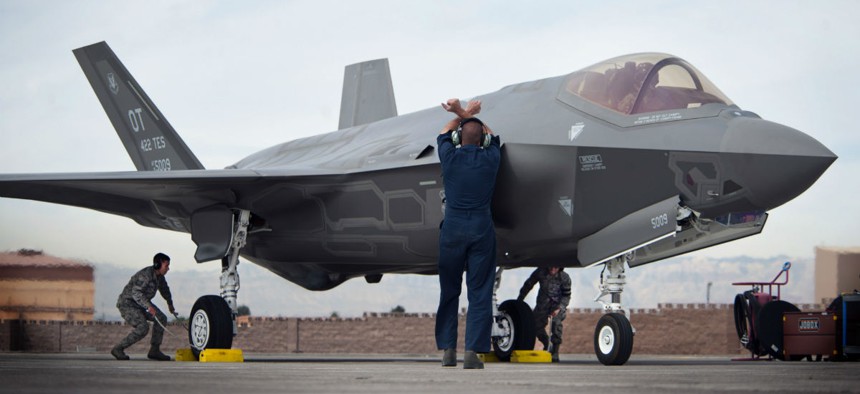
Crew chiefs from the 57th Wing Lightning Aircraft Maintenance Unit prepare an F-35A Lighting II for a training mission at Nellis Air Force Base, Nev. Lawrence Crespo / U.S. Air Force file photo
The Air Force Is Starting to Think About Its Next Strike Aircraft
Service leaders are laying groundwork for a new strike capability — even as they work to unground their F-35s.
Even as the U.S. Air Force is working to get its F-35s back in the air by year’s end, service leaders are starting to think about their next strike aircraft.
It is “absolutely essential that we look forward into the next generation of penetrating capability,” Chief of Staff Gen. David Goldfein told reporters who asked about the prospects for a new fighter to deploy along the F-35.
Echoing the service’s Air Superiority 2030 Flight Plan, released in May, Goldfein called for a new “penetrating counter-air” capability that would “push as far forward” as technologically feasible. He didn’t say whether that capability would take the form of a network of weapons and other technologies or a sixth-generation fighter jet.
But speaking Tuesday at the Air Force Association’s Air Space & Cyber conference just outside Washington, D.C., the chief of staff noted that the new capability would have to compete for resources with the Air Force’s other priorities.
“It’s very important, but it’s also a planning choice,” Goldfein said. “There’s a current fight that we’re in that requires a certain level of capacity, and that capacity has to have a current state of readiness.”
The general was referring to Operation Inherent Resolve, the U.S. fight against the Islamic State. The Air Force is doing much of the heavy lifting in the coalition operation, which as of May had already dropped more than 41,500 bombs on ISIS targets. Elsewhere at the conference, Air Combat Command’s Gen. Hawk Carlisle estimated that on any given day, 60 to 70 percent of the munitions are delivered by “the United States Air Force, and the other 30 to 40 percent is the Navy, the Marines, and the coalition put together.”
Meanwhile, the service is also piecing together funding to rebuild the force’s manpower and modernize its nuclear arsenal.
More immediately, the Air Force’s advanced air capabilities will depend on the scramble to bring the grounded F-35s back to operational capacity. After the service discovered that 57 jets—15 in operation use, 42 in production — were compromised by sub-standard tubing whose insulation crumbled into fuel tanks, it spent the next week and a half looking for a fix with the fighter jet’s manufacturer, Lockheed Martin.
The current solution — to be validated early next week on a Lockheed ground test airplane — is to cut holes in the F-35’s wings and go in through access panels to remove the faulty insulation, said Lt. Gen. Christopher Bogdan, the aircraft’s program executive officer.
“Probably within the next week or two we will start repairing airplanes,” Bogdan said. “Our first priority is the 15 airplanes in the field, and we will work our way back to resolving the 42 airplanes on the production line.”
As straightforward as Bogdan’s description may sound, don’t expect it to be completed immediately.
“I think the overall process for the 15 airplanes to be fielded will be completed in December,” he said. “We will spend most of October and November modding those airplanes and getting them back into a flyable condition.”
Both Bogdan and Carlisle said the problem is confined to these 57 aircraft, which were equipped with a faulty batch of installation supplied by a sub-contractor. There are no similar problems with other A-, B- or C-models, they said.







